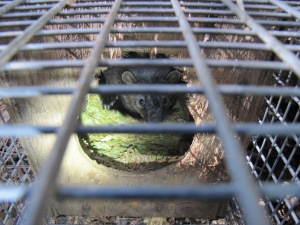The past few months have been diverse on the project for several reasons. Firstly, radio-tracking takes up a majority of the time spent in the field every week–checking in on up to 8 or 9 fishers a day in their respective territories means a lot of driving! However, before trapping started, finding radio-collared females was no problem, since we knew where each girl’s home ranges were. After the trapping frenzy this fall, it got a bit more hectic as all the females who were re-collared or new females who were fitted with collars began roving around the district like crazy, traveling several miles between days to different locations, and then moving again! However, it has since “settled down” quite a bit as all the females are beginning to settle nicely into their own ranges and are almost always found at any given time.
One of the other aspects of the project after the trapping frenzy of October/November was…yet more trapping! There are a few female fishers whose collars are dying, or who didn’t get captured during the first effort, that we are trying to catch before denning begins so we can check up on them (and give shiny new collars to!). So far, we have not had any luck catching “target” females but we did manage to catch a few incidental critters-as during the first bout of trapping!
Here is a frisky spotted skunk…
And a gray fox-
Ok, I can’t resist throwing in a female fisher captured from trapping in October! She is just too darn cute.
As many of you may know, this is the driest California winter since records have started being kept. Despite this, about a month ago we did get a big dumping of snow, which halted field work for a few days while we waited for roads to be safe to drive again. This was an great change of pace as we were able to see tracks in the snow that we don’t often get to see.
Here is a monster of a black bear’s prints–and my size 8 boot to compare:
Not far from this was a set of bobcat prints:

After a while, the fun dissipates as the snow melts and all the prints meld together into an indistinguishable muddy mess. In some colder drainages, like this one on Big Chico Creek, the snow made the scenery quite enjoyable:
But usually, there is always a “view of the day” no matter what the weather is like.
In a few months, mother fishers will be denning and we will be able to see exactly where they will choose to rest with telemetry and motion-activated cameras-so stay tuned!






